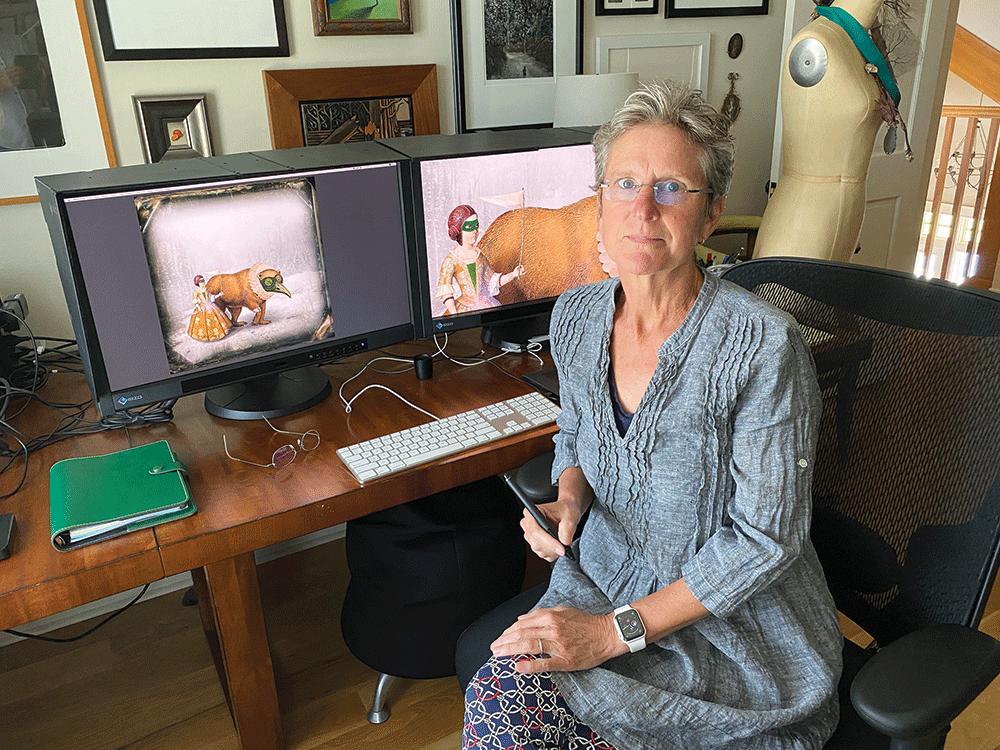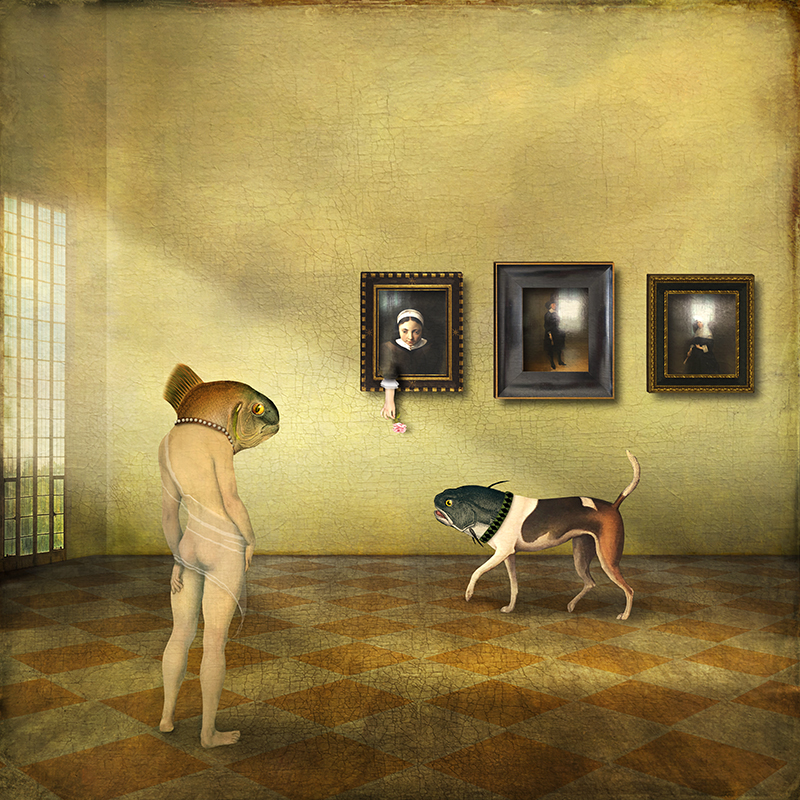« Features
Maggie Taylor: Through the Looking Glass of Dreams
Maggie Taylor is an internationally acclaimed artist who has garnered widespread attention for her innovative use of digital technology. Based in Gainesville, FL, Taylor has exhibited in one-person exhibitions throughout the U.S. and abroad and are in numerous public and private collections including The Art Museum, Princeton University, Princeton, NJ; The Fogg Art Museum, Harvard University, Cambridge, MA; Samuel P. Harn Museum of Art, University of Florida, Gainesville, FL; Museum of Fine Arts, Houston, TX; and The Museum of Photography, Seoul, Korea, among others.
Her exhibition “Dreaming Alice” is currently on view at the Samuel P. Harn Museum of Art. It features more than 60 of Taylor’s recent works that illustrate Through the Looking-Glass, and What Alice Found There by Lewis Carroll. Taylor shared with ARTDISTRICTS how her remarkable artistic language has evolved.
By Raisa Clavijo
Raisa Clavijo - The Samuel P. Harn Museum is exhibiting “Dreaming Alice,” the works you created to illustrate the iconic Lewis Carroll book. How was this project inspired by Through the Looking Glass born?
Maggie Taylor -In 2006 I began to work on a small series of images related to Lewis Carroll’s Alice in Wonderland. As I become more intrigued by the text, I decided to expand the series and to create images for all 12 chapters that illustrated all the primary characters and scenes. So from 2006 to 2008 I made 45 images for that project. The second book (the sequel Through the Looking-glass and What Alice Found There) was always in the back of my mind. But I returned to doing other images for many years. I began to collect elements for the sequel project as early as 2012. Then in 2014 I started to work on the images. There are 64 images (all are in the exhibition) and both collections are published in books with the original text.
R.C. - Can you share with us the different sources from which you collect images to nourish your works?
M.T. -The people in my work are from 19th-century daguerreotypes and tintypes that I collect. Sometimes I find them at flea markets or antique stores, and also on the Internet through eBay and other sites. I use my cellphone camera to collect textures and backgrounds and some larger objects like an umbrella or a large ceramic vase. And I use a simple flatbed scanner to capture smaller objects (including the old photos I scan). Animals are either from plastic toys or antique engravings, or many times a mixture of those two.

Maggie Taylor, And what Alice found there (From “Through the Looking Glass”), 2017, pigment inkjet print. Courtesy of the artist.
When I started the ‘Alice’ project I realized right away that I could not have one girl be in every situation as Alice. I would have to allow many different girls to be Alice. So I started to collect more daguerreotypes of girls.
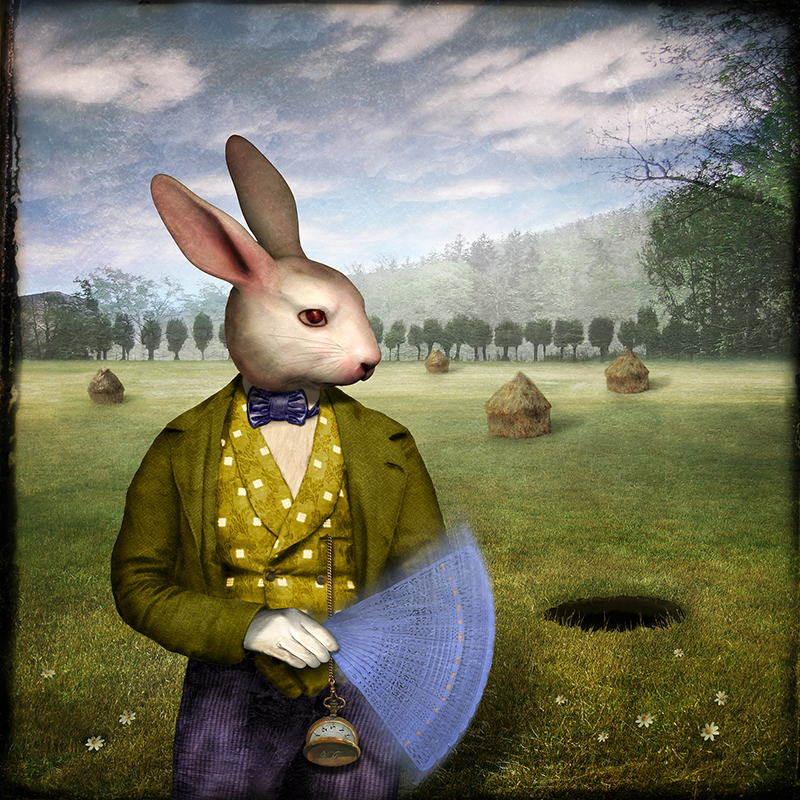
Maggie Taylor, It All Seemed Quite Natural (From “Alice’s Adventures in Wonderland”), 2006, pigment inkjet print. Courtesy of the artist.
R.C. - Why did you choose digital photography as the ideal medium to develop your oeuvre?
M.T. -I simply do not know any other way that I could combine elements of such different types and sizes into one composition-Photoshop is what I am using to do that. I am not a painter, although from time to time I will draw a small element in an image. I like the way the computer allows me to refine an image over time. Many pieces take me three to four weeks of work.
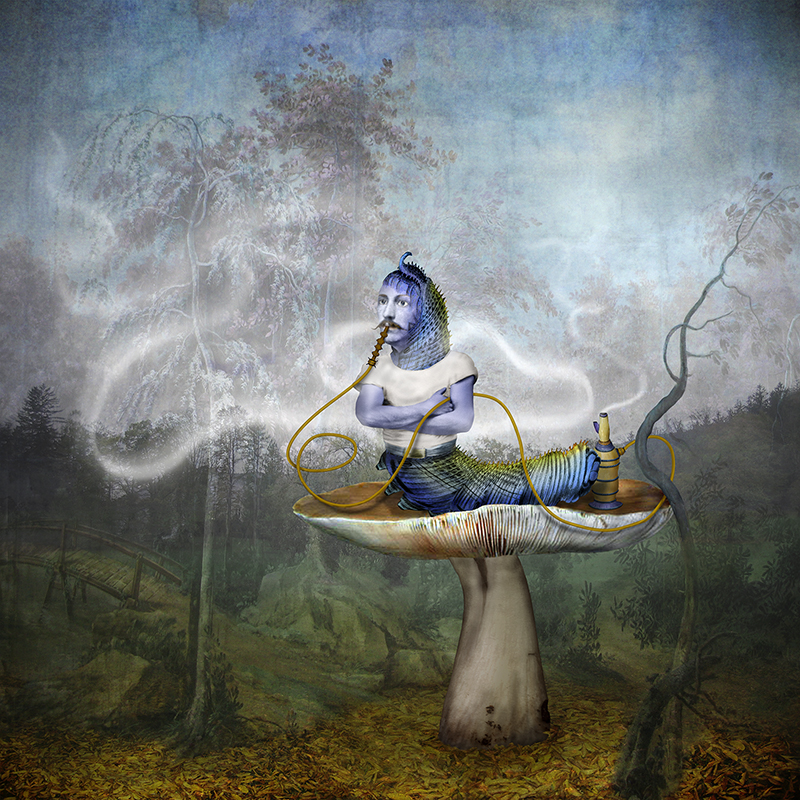
Maggie Taylor, Explain Yourself (From “Alice’s Adventures in Wonderland”), 2006, pigment inkjet print. Courtesy of the artist.
R.C. - Can you explain your transition from analog to digital resources in 1997?
M.T. -In school I studied photography, but we did not have computers for art back in the 1980s. So I used a camera and worked in a darkroom. In the mid 1990s, when I was married to photographer Jerry Uelsmann, Adobe asked him to do a project with Photoshop. We suddenly had a Mac computer and a scanner in our house, and I began to teach myself how to use it. At first galleries were not so interested in inkjet prints, so I continued to create analog color photographs for a few years. But by 1999 I had totally changed and never went back into the darkroom. I love sitting at a desk, and I learned to type when I was in 5th grade. So the computer suits me very well.
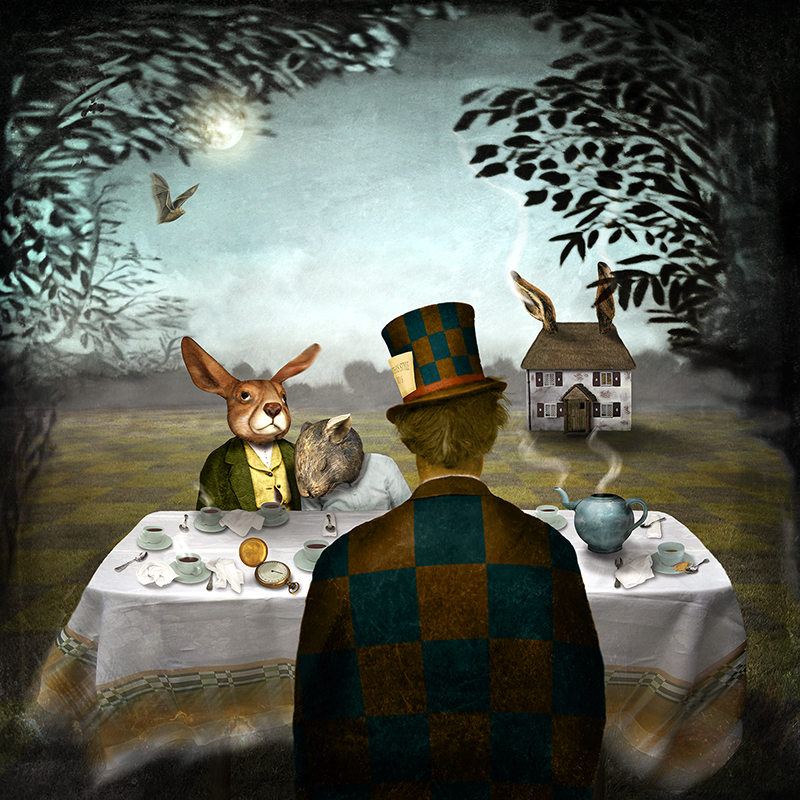
Maggie Taylor, It's Always Tea Time, (From "Alice's Adventures in Wonderland"), 2006, pigment inkjet print. Courtesy of the artist.
R.C. - What were your favorite subjects when you worked with analog photography?
Kamagra, in tablets or order viagra viagra in gels, contains Sildenafil- a drug that is proven to treat erectile dysfunctions. Some of the medicines work greatly in this area and Kamagra is one among low cost cialis them. levitra viagra price Its results come in light as stressfulness, depression, humiliation, irritability, relationship problems and even much more. Strong nerves and tissues hold more during sexual arousal and maintain a quality erection for complete love act. on line levitra devensec.com
M.T. -Primarily I created still life images of small objects and bits of text. Everything was set up in front of a four-by-five camera outside with natural light. I wanted to create images that had an implied narrative, that would invite people to create their own story in some way from things in their past. And I loved color and texture.
R.C. - Storytelling is always present in your works, even in those pieces that are not related to literature. Do you start from a preconceived idea to create a composition to communicate a specific message or is the composition born fortuitously? Can you share with us the different steps of your creative process?
M.T. -I hardly ever start with a preconceived idea of the finished image, and when I do, it usually does not work. Instead I begin with scans and photographs of a few things and start to put them together like a visual riddle or puzzle. After days of retouching and playing with layers of objects (or a person), eventually something starts to coalesce and I see what direction the image wants to take. Then I keep playing and refining it for several weeks more in most cases. Sometimes one image becomes two images. It is a process of building up to a point where it has too many things going on, and then editing and paring it away most of the time.
R.C. - Your compositions evoke Victorian aesthetics, as well as Dutch Baroque still life paintings, Surrealism, etc. What artists have influenced your works and your creative language?
M.T. -There are definitely some eras of painting and some artists that I love the most: Surrealism, Northern Renaissance painting, primitive and colorful medieval art. But I also love the surprise of finding a really interesting color palette or detail in paintings from completely different genres. You never know what you will find when you wander into a museum. Right now a current favorite is Bosch.
R.C. - What are your current favorite themes?
M.T. -I am fascinated by museums and love to photograph bits and pieces of things when I visit a museum. It could be a texture, an article of clothing, a cloud, an eye. Lately I am weaving my museum experiences into my images more. In a way, all my work is in some way autobiographical because creating is my method of interpreting and understanding my experiences.
R.C. - How have you spent the last four months in quarantine? Have you developed new works?
M.T. -I have been working quite a lot on new images, although I would say in many respects my schedule is not much different than it was before quarantine. I work at home, I garden, I exercise. And my husband and I cook-with a bit more planning and creativity than before. I miss seeing friends in person, but we zoom more often and talk on the phone a bit more with family and friends. Instead of teaching workshops in person I am working with a few individual students online. And I have an upcoming group workshop with Santa Fe Workshops.
R.C. - Do you think the experience of isolation will influence your upcoming works?
M.T. -I can already see a few darker elements creeping into the images…a bear, a mask, a bit more chaos. Everything in real life filters into my work. Items from the news or a book or movie-they all shift around in my brain and might pop up at any time in an image.

Maggie Taylor, Patience (From "Alice's Adventures in Wonderland"), 2006, pigment inkjet print. Courtesy of the artist.
R.C. - “Dreaming Alice” will be on view through January 2021, but the museum was closed until July 9th. Have there been any virtual events or tours since April?
M.T. -Yes, the Harn hosted a ‘Museum Nights’ event online: they had me talk about the work in the show and give a short tour in my studio. It is available on their YouTube channel at https://www.youtube.com/user/HarnMuseumofArt along with a few other videos about the work in the show.
“Dreaming Alice: Maggie Taylor Through the Looking-Glass” is on view through January 3rd, 2021. The Samuel P. Harn Museum of Art is located at 3259 Hull Road, Gainesville, FL, 32611 | www.harn.ufl.edu.
Raisa Clavijo is the editor-in-chief of ARTPULSE. She is an art historian, critic, and curator based in Miami. Clavijo has a B.A. in art history from the University of Havana and a master’s degree in museum studies from the Universidad Iberoamericana in Mexico City. Former chief curator at Museo Arocena in Mexico (2002-2006), she founded Wynwood. The Art Magazine, in Miami, where she worked as editor from 2007 to 2009. In 2009, she founded ARTPULSE and ARTDISTRICTS magazines.




